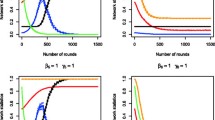Abstract
The article develops and analyzes the model of position selection by individuals in conditions of informational confrontation on two issues. We consider a society, in which two parties holding opposing positions on these issues are competing. The confrontation is manifested as follows: messages regarding these issues are distributed by each of the parties as information flows through affiliated media. Individuals absorb these flows, become supporters of one or party or the other on each of the issues, and relay them further to other individuals in accordance with their political preferences. The relative importance of the issues is determined based on the agenda-setting theory. This implies that the relative importance of the promoted issue is determined by the broadcasting intensity of both parties. Two variants of the mathematical model are constructed. One of them assumes interpersonal communications uniformly distributed throughout society and involves the consideration of system parameters affecting the stability of decisions. The second version suggests the presence of two groups (ethnic communities, social classes, etc.) in society, the members of which tend to communicate more with each other than with the representatives of the other group. For this variant, a simple Blotto game is considered: each party distributes its media broadcasting resource between two issues in order to maximize the number of supporters at the end of the propaganda battle.


Similar content being viewed by others
REFERENCES
1. A. P. Petrov, A. I. Maslov, and N. A. Tsaplin, “Modeling position selection by individuals during information warfare in society,” Math. Models Comput. Simul. 8, 401–408 (2016). https://doi.org/10.1134/S2070048216040141
M. E. McCombs and D. L. Shaw, “The agenda-setting function of mass media,” Publ. Opin. Quart. 36, 176–187 (1972).
M. McCombs and N. J. Stroud, “Psychology of agenda-setting effects: mapping the paths of information processing,” Rev. Commun. Res. 2, 68–93 (2014).
D. J. Daley and D. G. Kendall, “Stochastic Rumors,” J. Inst. Math. Appl., No. 1, 42–55 (1964).
G. K. Osei and and J. W. Thompson, “The supersession of one rumour by another,” J. Appl. Prob. 14, 127–134 (1977).
A. P. Mikhailov and N. V. Kliusov, “On the properties of the simplest mathematical model for the spread of information threats,” in Mathematical Modeling of Social Processes, Ed. by A. P. Mikhailov (MAKS Press, Moscow, 2002), No. 4, pp. 115–123.
A. A. Samarskii and A. P. Mikhailov, Principles of Mathematical Modelling: Ideas, Methods, Examples (Fizmatlit, Moscow, 2001; CRC, Boca Raton, FL, 2001).
N. A. Marevtseva, “The simplest mathematical models of information warfare,” in Mathematical Modeling and Modern Information Technology, Proceedings of the All-Russia Youth Schools (Yuzh. Fed. Univ., Rostov-na-Donu, 2009), No. 8, pp. 354–363.
A. P. Mikhailov and N. A. Marevtseva, “Models of information warfare,” Math. Models Comput. Simul. 4, 251–259 (2012). https://doi.org/10.1134/S2070048212030076
N. Kereselidze, “Combined continuous nonlinear mathematical and computer models of the Information Warfare,” Int. J. Circuits, Syst. Signal Proces. 12, 220–228 (2018).
R. Isea and K.E. Lonngren, “A new variant of the SEIZ model to describe the spreading of a rumor,” Int. J. Data Sci. Anal. 3 (4), 28–33 (2017).
A. G. Chkhartishvili, D. A. Gubanov, and D. A. Novikov, Social Networks: Models of Information Influence, Control and Confrontation (Springer, Moscow, 2019).
I. V. Kozitsin and A. A. Belolipetskii, “Opinion convergence in the Krasnoshchekov model,” J. Math. Sociol. 43, 104–121 (2018).
I.V. Kozitsin, “Generalization of Krasnoshchekov’s model for the case of a decomposable matrix of social interactions,” Math. Models Comput. Simul. 10, 398–406 (2018).
A. Chkhartishvili and I. Kozitsin, “Binary separation index for echo chamber effect measuring,” in Proceedings of the 11th International Conference on Management of Large-Scale System Development MLSD (IEEE, Moscow, 2018), pp. 1–4.
A. P. Petrov and O. G. Proncheva, “Modeling propaganda battle: decision-making, homophily, and echo chambers,” in Proceedings of the Conference on Artificial Intelligence and Natural Language AINL 2018, Ed. by D. Ustalov, A. Filchenkov, L. Pivovarova, and J. Žižka, Vol. 930 of Communications in Computer and Information Science (Springer, Cham, 2018), pp. 197–209. https://doi.org/10.1007/978-3-030-01204-5_19
L. Akhtyamova, A. Ignatov, and J. Cardiff, “A large-scale CNN ensemble for medication safety analysis,” Lect. Notes Comput. Sci. 10260, 247–253 (2017). https://link.springer.com/chapter/10.1007/978-3-319-59569-6_29
A. Boldyreva, O. Sobolevskiy, M. Alexandrov, and V. Danilova, “Creating collections of descriptors of events and processes based on Internet queries,” in Proceedings of the 14th Mexican International Conference on Artificial Intelligence MICAI-2016, Vol. 10061 of Lect. Notes Artif. Intell. (Springer, Cham, 2016), Chap. 26, pp. 303–314. https://link.springer.com/chapter/10.1007/978-3-319-62434-1_26
A. Boldyreva, M. Alexandrov, O. Koshulko, and O. Sobolevskiy, “Queries to Internet as a tool for analysis of the regional police work and forecast of the crimes in regions,” in Proceedings of the 14th Mexican International Conference on Artificial Intelligence MICAI-2016, Vol. 10061 of Lect. Notes Artif. Intell. (Springer, Cham, 2016), Chap. 25, pp. 290–302. https://link.springer.com/chapter/10.1007/978-3-319-62434-1_25
P. F. Lazarsfeld, “Latent structure analysis,” in Psychology: A Study of a Science, Ed. by S. Koch (McGraw-Hill, New York, 1959), Vol. 3.
N. Rashevsky, Mathematical Biophysics: Physico-Mathematical Foundations of Biology (Univ. of Chicago Press, Chicago, 1938).
A. P. Mikhailov, A. P. Petrov, G. B. Pronchev, and O. G. Proncheva, “Modeling a decrease in public attention to a past one-time political event,” Dokl. Math. 97, 247–249 (2018). https://doi.org/10.1134/S1064562418030158
A. Petrov, A. Mikhailov, G. Pronchev, and O. Proncheva, “Using search queries to analyze public attention to one-time political events,” in Proceedings of the 11th International Conference on Management of Large-Scale System Development MLSD (Moscow, Russia, 2018), pp. 1–5. https://doi.org/10.1109/MLSD.2018.8551806
Author information
Authors and Affiliations
Corresponding authors
Additional information
Translated by I. Pertsovskaya
Rights and permissions
About this article
Cite this article
Petrov, A.P., Proncheva, O.G. Modeling Position Selection by Individuals during Informational Warfare with a Two-Component Agenda. Math Models Comput Simul 12, 154–163 (2020). https://doi.org/10.1134/S207004822002009X
Received:
Revised:
Accepted:
Published:
Issue Date:
DOI: https://doi.org/10.1134/S207004822002009X



